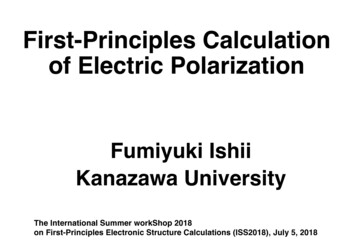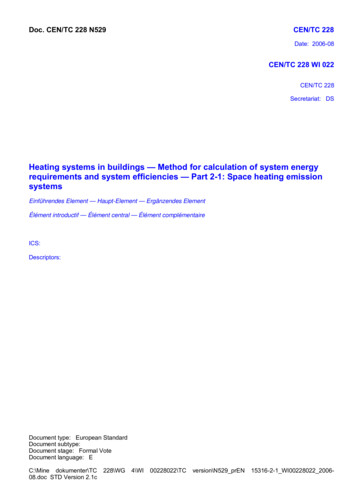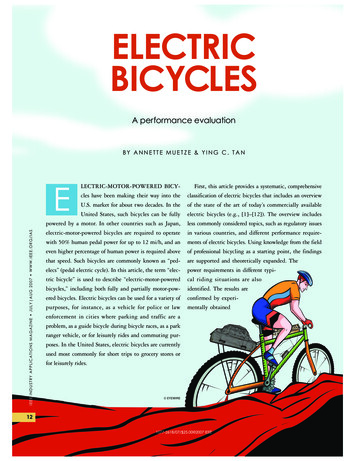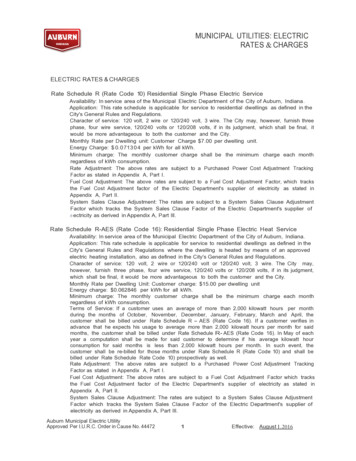
Transcription
First-Principles Calculationof Electric PolarizationFumiyuki IshiiKanazawa UniversityThe International Summer workShop 2018on First-Principles Electronic Structure Calculations (ISS2018), July 5, 2018
Electric polarization Fundamental physical quantity of insulators Characterize dielectric properties of insulators Piezoelectricity, Ferroelectricity, Magnetoelectric effect Many applications Capacitor, Piezoelectric device, Ferroelectric memory Momentum dependence: Characterize topological insulators
Perturbations and ResponsesPerturbations 1. Mecanical2. Thermal3. Electric4. Magnetic5. ChemicalResponses1. alMagnetostrictionOsmotic pressure2. ctric/Thermoelectric(Peltier)ThermomagneticHeat diffusion3. eebeck)Electric PolarizationElectric ConductivityMagnetoelectricBattery4. ricMagnetization5. ChemicalOsmotic pressureHeat diffusionBattery?diffusionBased on the table of Hidetoshi Takahashi
In the textbook The polarization P is defined as the dipole momentper unit volume, averaged over the volume of a cell.1 s1 sP pi rn qn - - Vs iVs n c1 rn qn1 cellVc n--- Periodic boundary conditionS:sample ,C:cellDipole sum of discrete charges
Problems in electric polarization Resta (1992):Contrary to common textbook statements,the dipole of a periodic charge distributionis ill defined, except the case in which thetotal charge is unambiguously decomposedinto an assembly of localized and neutralcharge distributions.P is not a bulk property, while thevariations of P are indeed measurable.
Can we compute P from charge density ?Charge distribution is continuous in real materials.R. M. Martin, PRB 9, 1998(1974).Local polarization fieldPel (r) Pel (r) ρ(r)1Pel cell P(r)drΩ11 cell drρ(r)r surface r[n P(r)]dsΩΩcell to cell term (current)Conclusion Absolute value of polarization is not bulk property Dipole moment divided by unit cell volume Polarization
Observation of electric polarization Current induced by perturbation PJ( λ ) λ Change in polarization by perturbationΔP J( λ )dλ Pdλ λA In classical way:j nevΔtΔP nevdt [ ner(Δt )] [ ner(0)]0 P(Δt) P(0)
Electric currents and polarization IElectric polarization expressed by wave functionX occXeP VHjdPdt eVeVeV hX occXhkn jrjk n 1kkn i En jdhdtk n 1X occX “h@tk n 11X occX Xkn jrjkn jrj(h@tk n 1 m 1kkkjrjihnmm j@tknikniknikniknj hkm ihkn i)kn jrj@tkm jrjknikni”
Electric polarization expressed by wave functiondPdt eV hX occX1X(h@tk n 1 m 1kkkjrjihnmm j@tknjkm ihkm jrjknikn i)Velocity operatork i!h mj[r; H]jk jvj k ihmnkkh mjrj ni kki!(En Em)kkkk h njrj mi (h mjrj ni)hkm jvjkniknikk i!(En Em)hkm jrjkni
Electric polarization expressed by wave functiondPdt ieV!X occXXk n 1 m6 n0@h@tkjnk ih k jvjmmkk(En Em)Bloch wavefunction and its periodic partknikHj nie ik r Heik r jukn i kn iHjukkh mjvj nij eik r jukn ik Enj knikEnjukn ikEnjukn ihukm j v jukn ikin1 c:cA
Heisenberg Equation of Motiondri! [r; H]dti!v [r; H]Bloch wavefunction and its periodic part e ik r Heik rH!dr ik rik r ik re[r; H]e ei!eik r i! vdtif [rk ; H] 0, ire ik r Heik r e ik r Heik r irrk H i[r; H] ! rk Hvhkm jvjkni hukm j v jukn i k rk Hhum jjukn i!
Electric polarization expressed by wave functiondPdt ie8ı 3 !ZdkBZoccXX0@h@tkjnk ih k jvjmmkk(En Em)kin1 c:cAn 1 m6 n01ZocckkkkX Xh@t un jum ihum j v jun i ie@Adk c:ckk8ı 3 ! BZ(E Enm)n 1 m6 n01ZocckkkkXX nih@ujuihujrHju ietknmm@Adk c:ckk8ı 3 BZ(E E)nmn 1 m6 nZoccX “” iekkkkdkh@t un jrk un i hrk un j@t un i38ı BZn 1
First-order perturbation theory H(k ‹H k) H(k)k kjuni jukn i Xm6 njrk ukn i ’Xm6 njukm ijukm i kn ihukm j‹ HjukkEn Em 2) O(‹ H kn ihukm jrk HjukkEn EmOrdinary derivative to partial derivativeddk juk ;t i @k juk ;t i @t juk ;t i @t juk ;t idtdt
Electric polarization expressed by wave functionZ t0 dPdt P ( t) P (0)dt ie8ı 3Z t ie8ı 3Z t00dtdtZZoccX “h@t ukn jrk ukn idkBZdkBZn 1occX “n 1@t hukn jrk ukn i hrk ukn j@t ukn i” rk hukn j@t ukn i”For k direction;P ( t) P (0)Zie dk dk‚ ˆ38ıZ t0dtZ G 0dk occX “n 1@k hukn j@t ukn i @t hukn j@k ukn i”
ElectricpolarizationnA dl @Sn 1expressedbyBerryphaseZoccX I occXt;k G “(King-Smith1993)k & Vanderbiltkn 1 0dk hun ( t)j@k un ( t)i ieP (t) 8ı 3 e8ı 3ZZdk dk‚dk dk‚occXn 1ImoccX Z G n 1 0Z G 0hukn (0)j@k ukn (0)idk hukn (t)j@k jukn (t)idk hukn (t)j@k jukn (t)i”
Electric currents and polarization XIExample: Orthorhombic unitcellCase: (k ; k‚ ) (0; 0) sampling , G P (t) ZoccXZ G 2ı,bG‚ 2ıcekkdkdkImdkhu(t)j@ju ‚ k nn (t)i38ı0n 1Zedk dk‚ ffi(t)38ıe 2ı 2ıeeaffi(t) ffi(t) ffi(t)38ı b c2ıbc2ıabc!eaeaffi(t)ffi(t) 2ı cell cell2ı
Computing Electric Polarization IINumerical calculation of Berry Phaseffi(t) occXImn 1Z G 0dk hukn (t)j@k jukn (t)iWe difine overlap matrix S(k; k0 ; t), whereSnm (k; k0 ; t) ” hukn (t)j@k jukn (t)i.We use well-known matrix identity, det exp A exp tr A,when A logS exp A S. log detS tr logS.ffi(t) Im ImZ G 0Z G 00kkdk tr@k 0 hun (t)jum (t)ijk0 kdk tr@k 0 S(k; k0 ; t)jk k0
Numerical calculation of Berry PhaseA logS exp A Sdet exp A exp tr A, log detS tr logSSnm (k; k0 ; t)jk k0 ‹mnffi(t) Im Im Im ImZ G 0Z G 0Z G 0Z G 0dk tr@k 0 S(k; k0 ; t)jk k0dk tr230@k 0 S(k; k ; t)45S(k; k0 ; t)jk k0dk tr@k 0 log S(k; k0 ; t)jk k0dk @k 0 log detS(k; k0 ; t)jk k0
Numerical calculation of Berry Phaseffi(t) ImZ G 0dk @k 0 log detS(k; k0 ; t)jk k0If we use k-point sampling mesh J along k direction,k ;s sG J and k G /J.ffi(t) Im lim k !0J 1Xs 0 k ˆlog det Snm (k ;s ; k ;s k ; t) log det Snm (k ;s ; k ;s ; t) k ffi(t) Im lim k !0J 1Xs 0log det Snm (k ;s k ;s k ; t)
Numerical calculation of Berry Phaseffi(t) Im lim k !0J 1Xlog det Snm (k ;s k ;s k ; t)s 0 Im lim log k !0J 1Ydet Snm (k ;s k ;s k ; t)s 0 G S 1SG0
e′1 1 η (k! N2 1,N! 3 1 N!Gi · P eσ i1 i2 i3 , ki′1 1i2 i3 ).VB N2 N3 σ i 0,i3 0 i 0ησ (ki i i , kGi · P i1 1i2 i3 ). 1 2 321V B N2 N3σi2 0,i3 0 i1 0 Overlapmatrix S in OpenMX(k)ψσµ(r)g thateik·r u(k)σµ (r),N!! (k)1(k)ik·r(k)iR·kψ e e un σµ (r),cσµ,iα φiα (r τi Rn ),σµ (r)(k)N iα!! (k)ψσµ(r) Neik·rnu(k)1 (r),σµiRn ·k ecσµ,iα φiα (r τi Rn ),N(k) (k k)!asiα(k)n1 !trix ⟨uσµ uσν⟩ in Eq. (3)isNevaluatediRn ·k ecσµ,iα φiα (r τi Rn ),Nn (3) isiα (k k)(k) matrix(k k)(k)erlap⟨u u⟩inevaluated⟨uσµ uσν⟩σµ σν⟨ψσµ eik·rEq.e ik·re i k·r ψσν as ⟩,(k)atrix(k k)(k) i k·r(k k)(k) (k)(k k)(k k)(k) ψik·r ik·r⟩, i k·r (k k) ⟨ψ e⟨u u u⟩ ⟨ψ eee⟩,⟨uσµ⟩inEq.(3)isevaluatedas ψσνσµσνσµσν σνσµ!(k)(k) 1 ! i k·r(k k)(k k) ik·(R ⟨ψ e ψ⟩, n Rn′ ) σµσν cce(k k)(k) ik·r ik·r i k·r (k k)σµ,iασν,jβ⟨u(k) u⟩ ⟨ψ eee ψσν⟩,N′ iα,jβσµ σν1 ! ! (k) (k k)n,nσµ ik·(Rn Rn′ ) (k) i k·r c(k k)ce σµ,iασν,jβ i k·(r R ⟨φiα⟨ψ(rσµ N eτin,n⟩, n′ ) φjβ (r τj Rn′ )⟩. ′ iα,jβRn ψ) eσν! (k) (k k) i k·(r Rn′ )1 !⟨φ(r τ R) e R′ ) τj Rn′ )⟩.iαjβn(r c i cne ik·(Rn φ ng thatNσµ,iα σν,jβn,n′ iα,jβ′r Rτi n ) eR i k·(r Rn′ ) φn,⟨φiα (r τir jβ (r τj Rn′ )⟩.′
ewe have1(k k)(k)(k k)⟨u(k) u⟩ σµ σν ⟨uσµ uσν⟩! !!! (k k) ik·(Rn Rn′ )1 c(k) (k) (k k) ik·(Rn Rce n′ ) σµ,iασν,jβ cceσµ,iασν,jβwe haveN n,n′ iα,jβN n,n′ iα,jβ!′ ′(k) ′n τ′ ! i k·(r τi R R′ n′ ) ′(k k) i k·(r Rn′(r) R(k) (k k) ⟨φ (r1i Rn′ )n ik·(R (rτi ττi j τjR(8⟨φiα (r ) e nR n R nR′ )⟩.(⟨uσµ uσν 1 ⟩! cσµ,iαcσν,jβe φiα! ) ejβ n φjβn′ )⟩.(k) (k k) ik·(Rn Rn′ )(k) (k k)N′ iα,jβ⟨uσµ uσν⟩ cn,ncσν,jβ e σµ,iαN n,n′ iα,jβ′ i k·(r′) Since dependseach termondependson ⟨φonlytherelative′ τposition, (8)Eq.(8)becomesi Rn R Rn′ ′ each termonly therelative,REq. φ(rτi becomesτj Rn Rn′ )⟩.(8)n′jβiα (r ) e position Rn nRn′′ τi Rn Rn′ )′!!⟨φ) e i k·(rτi τj′ τ i RRn′ )⟩.(8)iα (rnn (k) (k k) ik·Rn φjβ (r ′ i k·(r!!(k) (k k) R)′′(k) (k k)⟨u u⟩ cce ⟨φ(r) e φ(r τ τ Rn )⟩,(k k)ik·Rn′ Riα i k·(rijjβ′n ) becomesi Rσµσνσµ,iασν,jβ′ , τSinceeachtermdependsononlytherelativeposition REq.(8)nn⟩ cce ⟨φ(r) e φ(r τ τ Riαijn )⟩,jβσνσµ,iασν,jβn iα,jβch term dependsn ononlythe!relativepositionRn Rn′ , Eq. (8)′ becomes ′iα,jβ!!!(k) (k) (k k)(k k)(k) (k k)! !ik·Rik·R′ i R i k·(r τi′ Rn i k·r)′′nn i k·(τn)⟨uσµ uσν⟩ (k) cσµ,iαce ⟨φ(r) e φ(r τ ccee⟨φ(r) e φ(r τji τRj n )⟩,Rn )⟩,′iαijβiαjβσµ,iα(k k)σν,jβσν,jβik·Rn i k·(τi Rn )′ i k·r′!!′ τ cσν,jβik·Rene⟨φncσµ,iα(k) n (k k)iαi(riα,jβiα,jβ k)′ i k·(r R) e′ φjβ (r τi τj Rn )⟩,n)⟩ cσµ,iαcσν,jβ e ⟨φiα (r ) e φjβ (r τi τj Rn )⟩,ν! !n iα,jβ(k) (k k) ik·Rn i k·(τi Rn )′ i k·r′′n iα,jβ ccee⟨φ(r) e φ(r τi τj Rn )⟩, (iαjβσµ,iασν,jβThe exponentialfunctioninEq.(9)canbeapproximatedby! ! (k) n iα,jβ(k k) ik·Rn i k·(τi Rn )′ i y cσµ,iα cσν,jβ ee⟨φiα (r ) e φjβ (r′ τi τj Rn )⟩, (9)′e i k·r 1 byi k · r′ .(1n iα,jβThe exponentialfunction in Eq. (9) can be approximated′Overlap matrix S in OpenMXe i k·r 1 i k · r′ .onentialfunctionEq. (9) can be approximated i k·r′ byThus,Eq. (9)inbecomese 1 i k · r′ .Eq. (9)(k)becomes(k k)! !(k) (10(10)′(k k)ik·Rn i k·(τ i k·r′ i Rn ) ⟨u u⟩ cceee 1 i k·r.(10)σµσνσµ,iασν,jβThus, Eq. (9) becomesn iα,jβ! ! (k) (k k) ik·Rn i k·(τi Rn )(k k)"#!! c(k) ′′′′′⟩ cee (k k)σν(k)(k k)ik·R i k·(τ R)σµ,iασν,jβ⟨φiαc(r) φcjβ (r eτi τn je Rn )⟩i ni kq. ⟨u(9) becomes u⟩ · ⟨φiα (r ) r φjβ (r τi τj Rn )⟩ ,σµσν k) where⟩ νσµ,iα σν,jβn iα,jβn iα,jβ#!" ! (k) ′′′′′"#(k k) i k·(τ R the overlapintegralmomentumvaluen )i kspace,′ is ′the φ′ expectation⟨φiαc(r ⟨φ) φjβ (rτik·R inτR· ⟨φ(r ) rτj forRthe, (11(i′ ni)⟩iαandn )⟩ positiojβ (r ′ τi e(r) φjβevaluated nττeij i k· ⟨φj Rn )⟩ iα (r ) r φjβ (r τi τj Rn )⟩ ,σµ,iαiαc(rσν,jβ
Application
Electric polarization and waterdipole moment in ferroelectric iceMolecular SimulationVol. 38, No. 5, April 2012, 369–372First-principles study of spontaneous polarisation and water dipole momentin ferroelectric ice XIFumiyuki Ishiia*, Kei Teradab and Shinichi MiuraaaFaculty of Mathematics and Physics, Institute of Science and Engineering, Kanazawa University, Kanazawa 920-1192, Japan;Department of Computational Science, Faculty of Science, Kanazawa University, Kanazawa 920-1192, Japanb(Received 3 August 2010; final version received 16 October 2010)Using density functional calculations, spontaneous polarisation of proton-ordered ferroelectric ice XI phase is calculated forthe first time. Spontaneous polarisation along the c-axis of orthorhombic Cmc21 structure is calculated to be 21 mC cm2 ,which corresponds to water dipole moment 3.3 D. We have performed systematic calculation of the water dipole moment inproton-ordered ice without ambiguity.Keywords: water molecule; ice; density functional theory; electric polarisation; electric dipole moment, electronicstructure1.Introductionpolarisation. Moreover, the electric dipole moment of the
Problem: definition of dipole moment inperiodic system R. Martin (1974) Knowledge of thecharge density in aunitcell is notsufficient to determinethe polarization.P Ω 1P Ω 1 cellcellE.R. Batista, S.S. Xantheas, H. Jonsson (J. Chem. Phys. 111, 6011(1999))P (r ) d r3 P(r) n( r)rn( r)d r Ω3 1 surfacer[P( r) dS]
J. Chem. Phys., Vol. 111, No. 13, 1 October 1999Charge density partitionE.R. Batista, S.S. Xantheas, H. Jonsson(J. Chem. Phys. 111, 6011(1999))FIG. 1. Contour plot of the charge density of the water pentamer in theplane of the cluster. The figure displays the charge density partitioned according to the Voronoi I !dotted line" and Voronoi II !solid line" schemes!see text". In the Voronoi I scheme, the Voronoi cell is constructed aroundone center per molecule, placed at the center of nuclear charge. In VoronoiII, the Voronoi cells are around three ‘‘atomic’’ centers per molecule: one atthe oxygen atom and the other two !shown with crosses" on the O–H bonds,at 40% of the displacement from the oxygen atom to the hydrogen nucleus.Although both surfaces are very similar, the latter passes closer through theminimum of the charge density between the molecules.and Voronoi IIously describedassociated withing to each of tresponding toobtained for the!iv" MolecThe electronicspace is partitioportion to the eecules at that pThe resultsfour schemes ainduction modeBriefly, every wmodel as a poinpole moment tmolecule.44 Thebors induces bused the experiquadrupole mooctopole andmeasured molesults of previoquadrupole, AC i j,kl , 46 and thof the momentshown in Table
Downloaded by [Kanazawa Unive3.Results and discussionF. Ishii, K. Terada, S. Miura,Siml.the38 calculated369 (2012).Figure Mol.2 showscharge density contourmap of ice XI phase. Significant charge density 0.01e0.1 e/bohr3 can be seen on the hydrogen bonds at theðkx ; ky ; kz Þ, respectively. As tunit cell, the valence elecoccupied bands are 32 svalence band top is at 2 0.3direct bandgap of about 6 eV0 eV with dispersion fordelocalised nature of electroby the Bloch wave functionCalculated water dipomolecule is 1.9 D in thein good agreement with expis no interaction betweenCharge distribution in ferroelectric ice(a) 10Energy (eV)50–5–10Figure 2. The charge density of ice XI phase viewed froma-axis perpendicular to the polarisation direction. Contours aredrawn on a logarithmic scale (from 1.0e-4 to 1.0 e/bohr3).ΓZUXFigure 3. Electronic structu(a) band structure and (b) total dtop is taken at the origin of the
F. Ishii, K. Terada, S. Miura, Mol. Siml. 38 369 (2012).Water dipole moment in hypothetical crystalMolecuWater dipole moment (D)4.543.532.521.52.533.54ROO (Å)4.555.5Figure 4. Water dipole moment of model ice with a perspectiveview of the structure. The triangle indicates water dipole momentversus oxygen– oxygen distance ROO. The lines are a guide to theeye.spontaneous polarisation of ice is simply the sum ofROO ¼ 5.4 Å to 4.0 D at ROO ¼ 2.4ROO becomes, the larger the waterealised; a steep increase is found aowing to the condensed phase effectmediated covalency [16]. For the liquin oxygen – oxygen distribution functibeen estimated to be between 2.69The corresponding dipole moment inbe 3.3 D, although spatial disorder in taccounted for. The value is slightly lacalculated value for liquid water phfunction approach [6]. This differenferroelectric order of water moleculewater molecules are disordered in the4. SummaryBy using density functional calcupolarisation of proton-ordered ice X
Electric polarization Fundamental physical quantity of insulators Characterize dielectric properties of insulators Piezoelectricity, Ferroelectricity, Magnetoelectriceffect Many applications Capacitor, Piezoelectric device, Ferroelectric memory Momentum dependence: Characterize topological insulators











